John Frusciante on the stories behind 5 standout Unlimited Love tracks
The Red Hot Chili Peppers guitarist takes us behind the writing, gear and recording of some of the biggest songs on the Californian rock institution’s new album
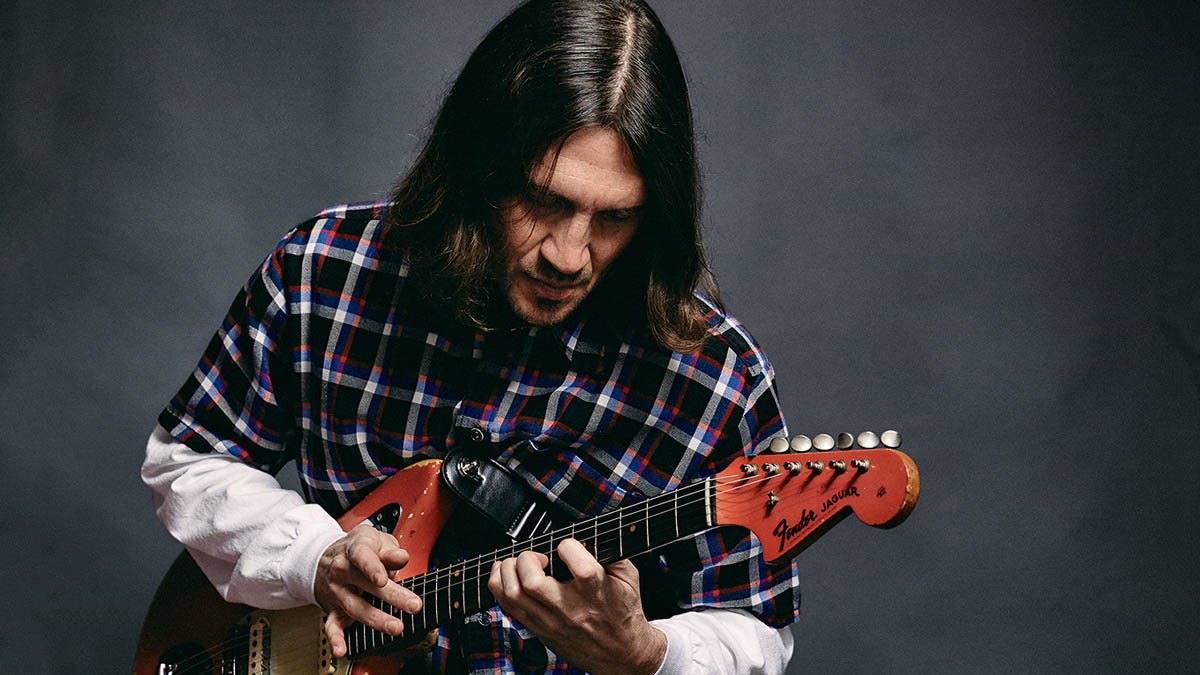
The Red Hot Chili Peppers’ Unlimited Love is one of the biggest rock albums of 2022, and one of the biggest guitar albums, too. It finds the Chilis at their most expansive.
Here, prodigal six-stringer John Frusciante – a player of abundant abilities – walks through a handful of the album highlights, recalling how they came together, what gear was used, and how they cam to be.
From the gentle acoustic Tangelo to the electric guitar freakouts of The Heavy Wing and more, he describes a songwriting approach that foregrounds dynamics – one that really gets going when he and bassist Flea put their heads together, literally.
Black Summer
“Through all the time that I wasn’t in the Red Hot Chili Peppers, there were only a few years that I was even using guitar in my music. But I kept on practicing, because practicing is something I do to stimulate the brain in interesting ways. I still hadn’t written any songs, though.
“But now the possibility of me rejoining the band came into the air when Flea started talking to me about it, and so I picked up my guitar and I went, ‘Hmmm… I wonder if I can still write a rock song?’ Because my whole sense of melody had switched to a completely different vocabulary.
“My memory of it is that I picked up my guitar and Black Summer came out. I wrote the initial idea for the verse and the chorus. I had a verse and chorus melody, too, but Anthony made up his own melody for the chorus and only used my melody that I had for the verse. And the thing he did in the chorus is way better than what I did originally.
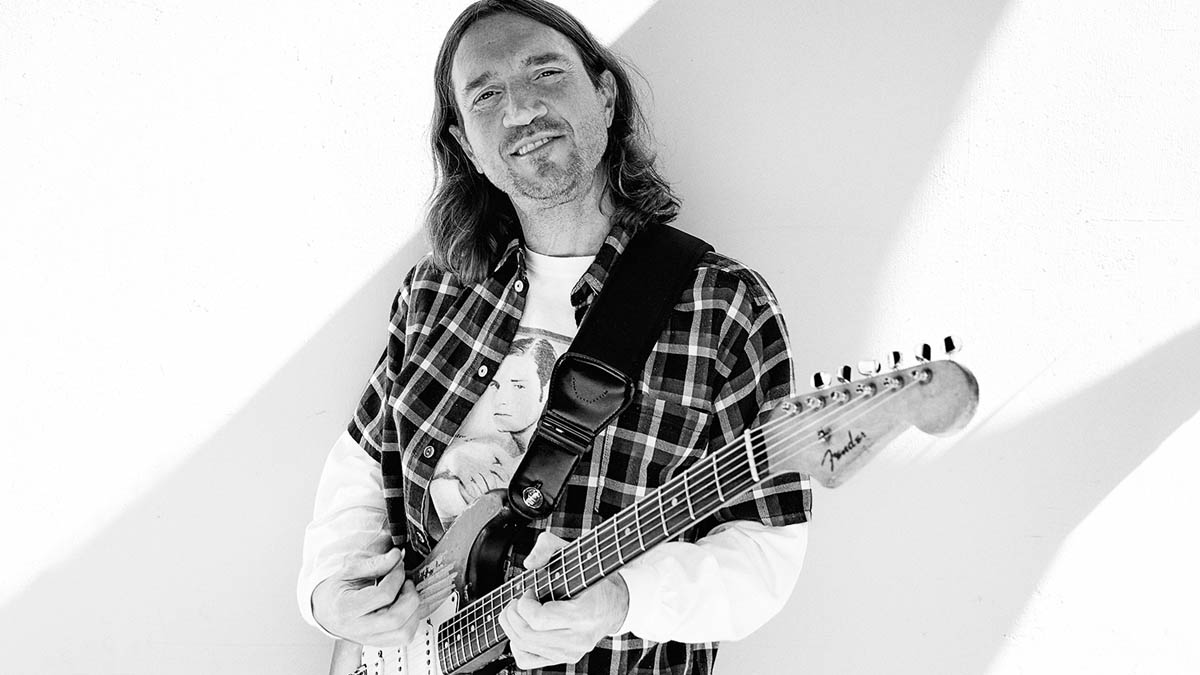
“One thing I’m very into is chord changes, where the chords are almost like a melody, and they’re not dependent on the bass line moving with them.
Get The Pick Newsletter
All the latest guitar news, interviews, lessons, reviews, deals and more, direct to your inbox!
“The changes and the little modulation things that take place in Black Summer, the fact that there’s an A major chord in the chord progression in the verse, but then there’s an A minor chord in the next line, simple little things like that are the kind of things that I find interesting.
It’s not like I’m thinking, ‘Wouldn’t that be cute if I switched the major to a minor?’ It’s just that this is what moves me
“Or having there be an E major chord in the chorus, but in the verses, the E chords are minor. These are the kind of little mental exercises that make writing chord changes fun for me. And it’s visceral. It’s not like I’m thinking, ‘Wouldn’t that be cute if I switched the major to a minor?’ It’s just that this is what moves me.
“And I also think it keeps a song moving in a way that makes unexpected feelings come up. Even if you’re a non-musician, when that moment happens, a shift in your emotional reaction takes place.”
Veronica
“Flea and I, we’ve always done these things called ‘faceoffs.’ If we’ve been jamming and maybe we’ve got a good verse that we came up with, but it needs another section, in the old days we used to literally put our foreheads next to each other and give each other kind of a mean look. And then it would be, ‘Okay, I’ll go outside. You can stay here.’
“We’d go in separate rooms, and I’d write a section and Flea would write a section. We’d both attempt to write a chorus or a bridge or whatever it was, and then we’d come back into the room and one guy would play everybody his part, the other guy plays everybody his part, and one of them makes it into the song. Or sometimes both of them made it into the song.
“I’m a big fan of tempo changes. It’s one of my favorite things about Black Sabbath – their first four records have all these tempo changes that take place within the same song. Another example would be Some Velvet Morning by Lee Hazlewood and Nancy Sinatra or We Can Work It Out by the Beatles.
“I thought, ‘That’s something we don’t have on any of our songs – a chorus that’s a completely different feel and tempo than the verse. And that became the object of Veronica. The verse is in 4/4, but the chorus has a triplet feel.

“Another thing about the song is that wawawawow kind of filter effect in the verse. Some people probably think it’s a guitar effect, but it’s actually my modular synthesizer.
“And we did all these backwards reverb treatments, sometimes on one instrument, but sometimes on the whole band, to make those tempo changes seem even more fluid. My ear is always looking for things like that – how can we make the recording more colorful without compromising the rawness of it?”
The Heavy Wing
“There was some song, it was either by Syd Barrett or the Move, where it was a really great song and the chords were E major, D major and A major. And I thought, ‘Those chords can be so powerful. I should write something with those chords.’ But I also thought, ‘Let’s start with those chords and then see what other realms I can take it to.’
“I started the song with just a simple funk riff. Because of my obsession with breakbeats and electronic music, I listen to a lot of funk music from the late Sixties and early Seventies. And so I thought, ‘I’ll start out with a riff that sounds like you could be getting into a funk song, but then it’ll go into this psychedelic world.’
“The guitar in the verse is treated with the modular synth, just to give it some subtle sonic movement. And in the breakdown before the solo, you hear the same guitar playing the same part as in the intro to the song, but being sent through a more pronounced modular treatment.
“There’s also a modular treatment on the guitar in the last four bars of the solo on Black Summer – very subtle, but stereo – and it made a big difference. These are just more examples of my using the synth rather than guitar pedals.
“For the guitar solo, I had my ’62 Strat, which has been my main guitar since I rejoined the band the first time, for Californication, and I was playing it really loud through all four cabinets of my Marshall. Like, so loud that I had to wear headphones or I would blow my ear off.
“I was in a pretty big room, so I had really good range to be able to stand at different distances and move around while I was playing to get different kinds of feedback from different places.
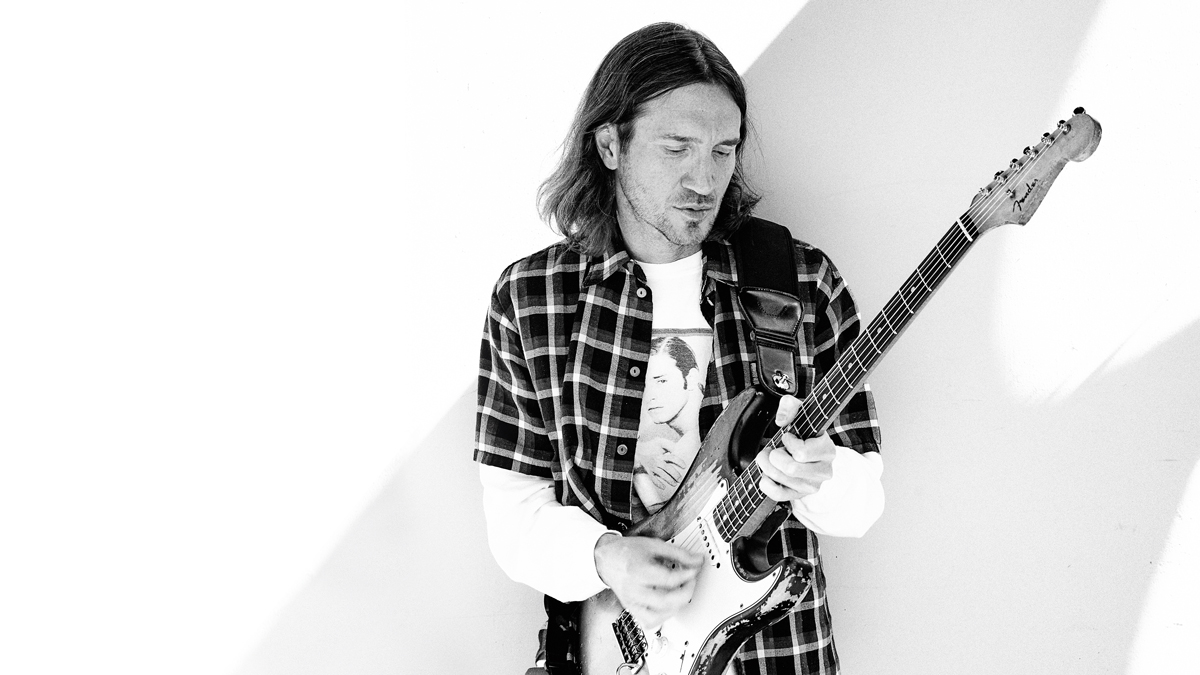
“There’s a point in the solo where I’m feeding back and bending a couple of notes back and forth, and then it goes to a higher octave, and then it goes to two octaves higher than that.
“It almost sounds like the kind of screeching feedback that people try to avoid, but you still hear that I’m bending the notes the same way I was when the feedback started. I didn’t plan that. I had no idea that those notes were going to happen. But when something like that happens, all you can do is just hold it and hope you don’t lose it.
“I really like that aspect of soloing – not so much planning something out and being like, ‘All right, here we go,’ but more just listening as you’re doing it, and then responding to what you’re listening to.”
The Great Apes
“The Great Apes was something Flea brought in. In the chorus, the guitar part I play is just what his bass line brought out of me. It’s definitely a Fugazi-inspired thing. The fact that I’m picking fast, but playing a melody that’s kind of a slow melody, that feeling that it expresses is something that I hear in their music a fair amount. At the same time, those slides that happen in the midst of it are very much Johnny Thunders-inspired.
“I’ll tell you a little studio trick that we did on this one, because it sounds like I’m doing something more amazing than I actually am. At the outro, Flea and I do this switch.
“For most of the song, during the chorus I’m playing the melody we’ve been talking about and Flea’s playing the chord changes. But when it goes to the outro, I’m playing Flea’s chord changes and he’s playing my melody. And somehow it sounds more bass-y, by the way, when I start playing the chord changes!
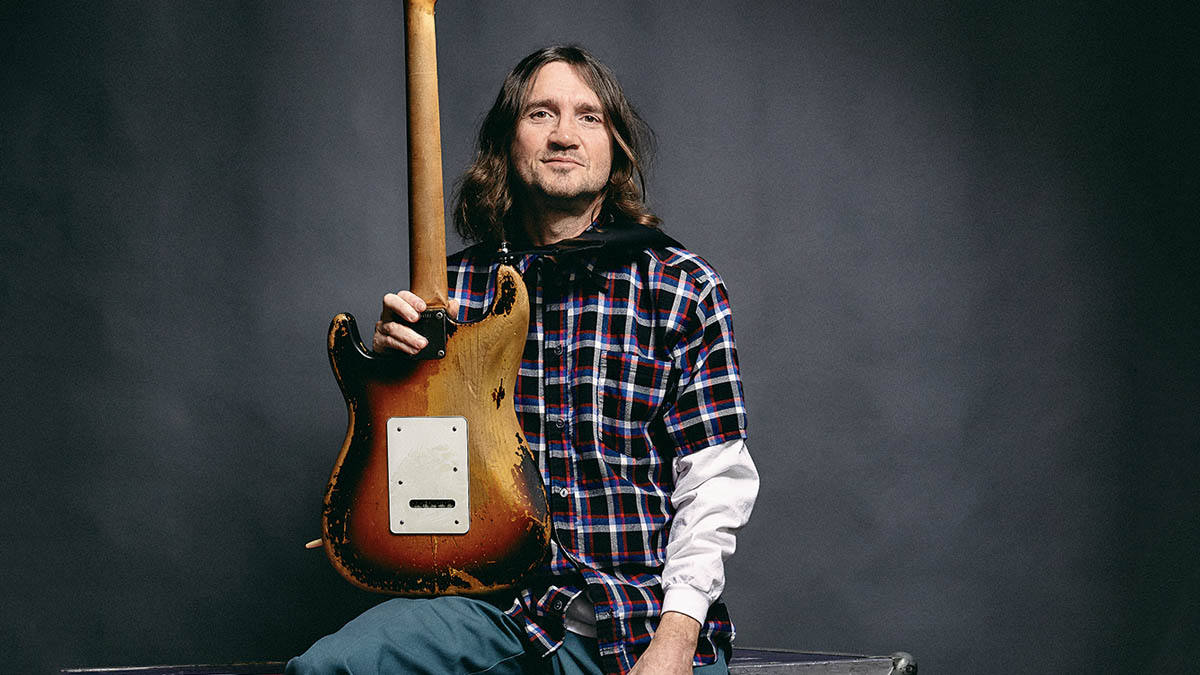
“Another thing about the outro: I’m playing those chord changes at the end, but then in the last few bars of the song I go back to soloing. I had two guitars – I’m pretty sure it was my Stratocaster through a distortion pedal on one side and a Yamaha SG 2000 straight into a Marshall on the other, and I would double them for that Black Sabbath-type of power.
“But I started soloing so fast that I couldn’t double it. I tried, but it was way too fast. And so we did an artificial double for that, with delay and some tape speed manipulation. The tape is just slightly moving, so the parts are not exactly the same.
“Because when you double something, that little difference in the parts is what gives it that power. So what you’re hearing gives the impression that I actually played the same thing twice, even though in this case I didn’t.”
Tangelo
“We were toward the end of the writing process, and I was thinking in terms of, ‘Okay, what styles are we missing?’ Because for a while we had a lot of funk and we had a lot of fun music, but it seemed like we were kind of light on heavy stuff. And so that’s when I was bringing in The Heavy Wing and some other ones.
“But I also realized we were missing very soft, gentle things as well. And so I wrote Tangelo just to fill up that space. I figured I’d write a fingerpicking thing for acoustic guitar. And again, it was one of those things where I had a melody, and what Anthony did with it was inspired by my melody, but it was also completely different in a lot of ways.
“He brought it into this almost Lou Reed-esque kind of half-talking, half-singing thing, whereas my melody was a very strict kind of melody that followed the chord changes.
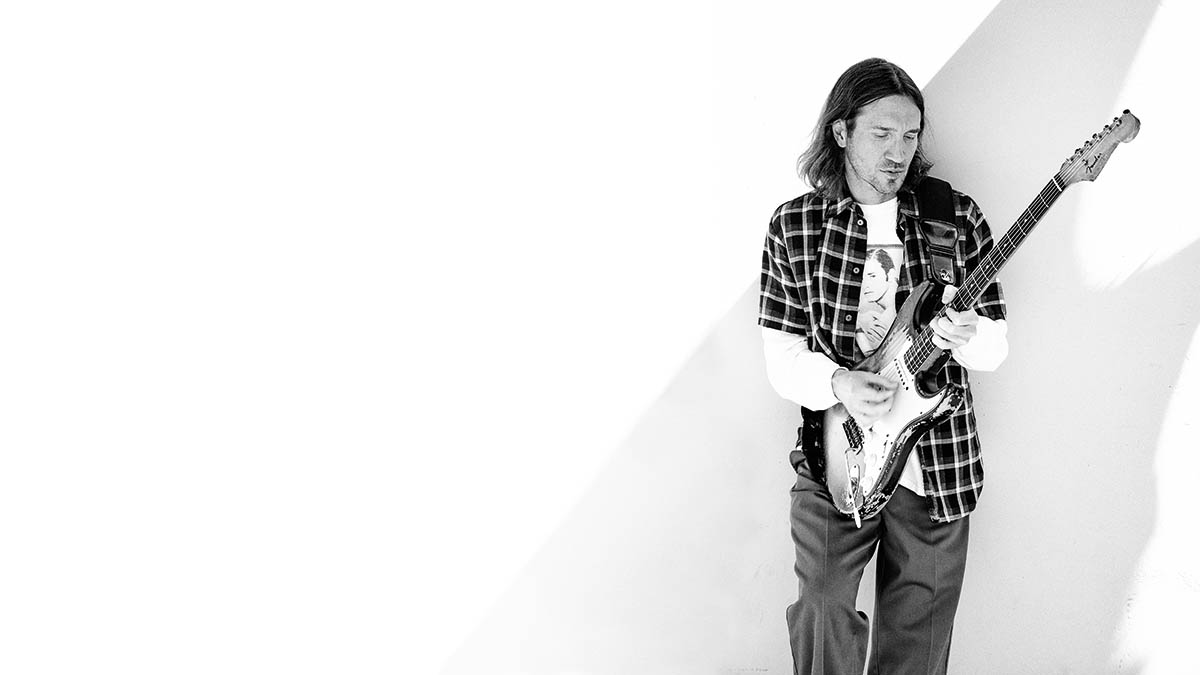
“I played the acoustic part on two different guitars. They’re both Martins – I don’t remember the models, but these are guitars I’ve had for a long time. One of them is a brown Martin that’s kind of small. It’s from the Forties or Fifties. And then the other one, it’s a Martin from the Sixties that looks like the guitar John Lennon plays in the Magical Mystery Tour film. Those guitars are my babies.
“The overdubs on this one were fun. I remember it was the very last day we were in the recording phase of the album, and I was supposed to be going home that day. I felt like I didn’t have anything left inside me. I felt completely drained. And then I thought, ‘Let me just try a little thing…’
“I started with one Mellotron, and then I wound up overdubbing synths and Mellotrons feverishly for, like, three hours, coming up with those parts that start in the second verse and go up until the last verse. It felt like it lifted the song to this other level. And it was really unexpected – I thought I had nothing in me and then I had all that come out of me. It was a really nice way to leave the studio.”
Rich is the co-author of the best-selling Nöthin' But a Good Time: The Uncensored History of the '80s Hard Rock Explosion. He is also a recording and performing musician, and a former editor of Guitar World magazine and executive editor of Guitar Aficionado magazine. He has authored several additional books, among them Kurt Cobain: Montage of Heck, the companion to the documentary of the same name.











